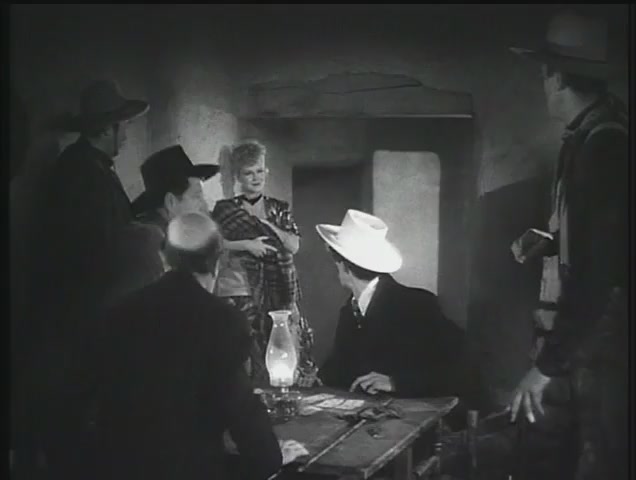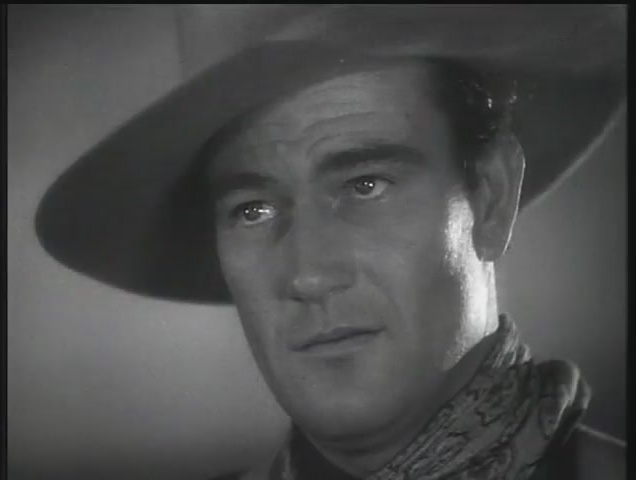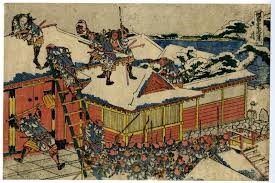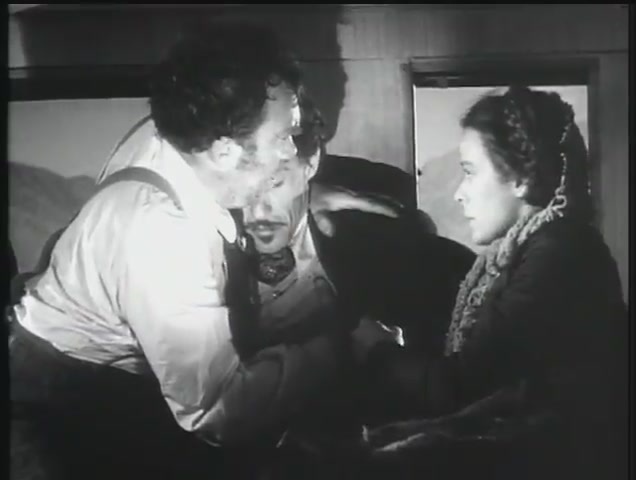THE American WESTERN
By Jeffrey-Baptiste Tarlofsky
By Jeffrey-Baptiste Tarlofsky
Lesson 5 consists of six video lectures and transcripts of those lectures, and four film excerpts. Start with excerpt #1 from Stagecoach and continue down the page in sequence until you reach the end of the lesson.
レッスン5は6本のビデオレクチャー(レクチャーのテキストがビデオレクチャーの下に記載されています)と4本の.動画(映画の抜粋)で構成されています。
このレッスンは、ページをスクロールダウンしながら最初から順番に動画を見たりテキストを読んでください。このレッスンでは、Reading Homeworkはありません。
その代わりに、レクチャーの終わりか途中で、「…について考えてください」という質問にあなたがどう思うかをノートに書き留めておいてください。これは、提出する必要はありません。このノートに書き留めた内容は、後日、参照できるよう保存しておいてください。そうすることにより、レッスンの内容をさらに理解できるようになったり、また、今後、出されるクイズに回答する場合に参照できるようになります。。
Directed by: John Ford
Produced by: Walter Wanger
Screen play by: Dudley Nichols
Based on: The Stage to Lordsburg 1937 by Ernest Haycox
Starring: John Wayne, Claire Trevor, Thomas Mitchell, John Carrdine, Andy Devine, George Bancroft
Music by: Richard Hageman
Wanger Productions: Distributed by United Artists
Running time: 96 minutes
Budget: $531,374
Box office: $1,103,757
Part 1 – Japanese people have something they call “American coffee” . This name was given to the coffee the American soldiers drank during the occupation immediately after World War Two. It was weak and watery because there was still rationing even after the war. Rationing means that there was a limited supply of something so you could not have all you wanted. I remember my father telling me that during the war rationing meant you could only have about one cup of coffee per day.
So, Japanese mistakenly thought Americans drank weak coffee, but that wasn’t really true. In fact, coffee in the Wild West during the age of the cowboy was a very, very different drink. It was strong. It is this strong coffee Doc calls for. “Bring me coffee” he says, “black coffee”. Westerners drank their coffee thick and black and hot. How thick? “As thick as molasses”. How black? “As black as midnight”. How hot? “As hot as Hell!” . That is what they called cowboy coffee. Of course it wasn’t really “like molasses in Hell at midnight “…but it was strong!
Doc needs strong coffee to help him sober up because he needs to help Mrs. Mallory have her baby. This is quite serious because childbirth in the past was dangerous. Today, in the developed world, only about one in every 10,000 births leads to the death of the mother. But at the time Mrs. Mallory was giving birth the death rate was 50 times greater, (about one in every two hundred births lead to the death of the mother). The best chance a woman had for survival while giving birth was to be attended by a doctor. Doc Boone has to sober up because Mrs. Mallory’s life and the life of her baby could depend on him.
We know Doc was successful because Dallas comes out carrying Lucy’s healthy baby girl and tells everyone Lucy is going to be alright. In image #1 we see everyone happily looking at the new life that has joined them on their journey. No one looks happier than Dallas. Ford gives us a closeup of Ringo looking at Dallas holding the baby (image #2). Before going on to Part 2 try to imagine what Ringo is thinking as he looks at Dallas.


Part 2 – Well, you probably guessed it. He is looking at her and imagining her as the mother of his children.
Doc comes out looking tired but pleased and Mr. Peacock greets him warmly with the words “Doctor Boone”. This is a very important moment in the film for Doc. It is the moment when his character is transformed from a half comical/half tragic drunken clown into… “Doctor Boone”, a man people can trust and depend on. Notice that John Ford does not suddenly have Doc stop being an alcoholic. Indeed, the first thing Doc does after delivering the baby is reach for a drink, but there has been a great change in Doc. By successfully helping Mrs. Mallory deliver her baby Doc has achieved redemption. Redemption is not only a key theme in this film, it is a key theme throughout the entire Western genre so it is important that you understand what the word means. By “redemption” I am referring to the idea that someone can save themselves (or be saved) from sin, error, or evil.

In Stagecoach, Ford pairs redemption with another key theme in the Western, vengeance (the taking of revenge). If someone has hurt you or someone you care about, or has done some great act of evil, you choose to take revenge on them. In fact, it may be your duty to take revenge. Vengeance is a very familiar theme in Japanese Jidai geki. In fact, Chushingura perhaps the most famous of all Japanese dramas, is a story of vengeance. The forty-seven loyal samurai are taking revenge on the evil person who caused the death of their lord. According to the code of the samurai, they are duty bound to take revenge on the evil doer.
But suppose for a moment that you are the evil doer? Then what happens? This is actually a very popular theme in many westerns. A man (or woman) has done some evil thing and brought shame or disgrace on themselves. They must seek redemption. Redemption is how you repay the debt you owe for having done an evil thing and/or having brought disgrace or shame on yourself. It is how you restore the balance in your life and become good again and regain the respect of others and also your own self-respect. In Western films, redemption is usually achieved through self-sacrifice and doing good deeds, especially helping those weaker than oneself. Western heroes are usually men (and sometimes women) who are seeking either revenge or redemption (or possibly both). Revenge and redemption are similar in that they restore balance to the moral universe in which the story takes place. Before you go to Part 3, pause for a moment and think about each of our characters in this film. Who is seeking revenge? Who is seeking redemption?
Part 3 – In Stagecoach, three of the characters are in need of redemption and one, Ringo, seeks vengeance. Both Doc and Dallas redeem themselves by helping Mrs. Mallory have her baby and Mr. Hatfield also redeems himself by helping Mrs. Mallory later in the film.
As the film progresses, Ringo follows Dallas outside and warns her not to wander too far, (another reminder of the constant threat the Indians pose). Dallas asks Ringo why he doesn’t try to escape, but he tells here that he is going to Lordsburg to take revenge on the Plummer brothers for murdering his father and brother. He says “I guess you don’t know how it feels to lose your folks that way”. But she does! She explains that her family were all killed by Indians when she was a small child. Suddenly these two outcasts, the outlaw and the prostitute, have something more in common than just being outcasts. They have both experienced the trauma of having their families killed. It is extremely sad and tragic, but suddenly each of these two young people have found someone who knows exactly how they feel. Imagine that, finding someone who really understands how you feel, your very deepest feelings. People fall in love all the time and sometimes it is simply because of sexual attraction, but that is not what is happening between these two. What starts as sympathy for each other turns into understanding and from that understanding grows love. There is something very mature, very adult, about this relationship. But…watch Excerpt #2
Part 4 – Dallas tells Doc that Ringo has asked her to marry him, but Doc, older and wiser, warns her that the relationship is doomed. It can’t work. It can’t work because Ringo is going back to jail…or is going to get himself killed in a gun fight…and besides, what will happen when this eighteen-year-old boy discovers the girl he loves is a prostitute? But Dallas begs Doc just to say it is okay for her to be in love and Doc finally tells her “Do it, if you can”. Maybe there is hope.
Meanwhile, the group is faced with another decision; to stay where they are in order to let Mrs. Mallory regain her strength, or flee because of the threat of an Apache attack. The question is really whether the group is willing to risk everything for the well-being of only one person. As they debate this, Dallas and Ringo are again talking together. She urges him to escape and forget about revenge. She tells him his desire for revenge will probably just get him killed and she sensibly asks “would killing Luke Plummer make us any happier?”
But, of course it isn’t a question of what would make them happier, it is a question of what Ringo’s duty is.
It is his sense of duty which makes Hatfield offer his protection to Lucy, it is his sense of duty which makes Doc sober up so he can help Lucy have her baby, it is even duty that Gatewood talks about when he demands the soldiers accompany the stagecoach. Duties are our obligations to do what is right. For just a moment Ringo forgets his duty and thinks of the happiness he and Dallas might have together if he escapes and she meets him later. But let me ask you to think about this: could Ringo ever really be happy if he did not try to do his duty and take revenge for the murder of his father and brother?
Ringo isn’t really given a chance to decide whether he should do his duty or just try to be happy because he sees the smoke signals from the Apache and knows he cannot escape. It is clear to everyone that they no longer have a choice. The Apache are almost certainly preparing to attack soon and their only hope is to try to escape as quickly as possible.
Part 5 – The ferry used to cross the river has been burned, but these people are clever and brave and determined. They turn the stagecoach itself into a kind of ferry which allows them to cross the river to what they believe is safety on the other side. But we see that they have fallen into a trap. The Apache are waiting for them.
Doc’s toast to their escape when they have not yet arrived safely seems like bad luck and he has accidentally forgotten to include Mr. Peacock in the toast. But everyone is reminded that Mr. Peacock is there when he is suddenly struck by an Apache arrow. This is an extraordinary moment in the film. The entire movie is 95 minutes long and the arrow strikes Mr. Peacock at almost exactly 70 minutes into the film. It is the first time we actually see any violence in the film. Westerns were notoriously violent, but in this film there has been no violence of any kind for the first 70 minutes. Ford didn’t need violence. But in this moment he changes the entire mood of the film by not just having the violence start just as everyone believes they are safe, but also by making the violence exceptionally shocking.
We spoke earlier of the Hollywood Production Code. These were the rules that did not allow John Ford to use the word “prostitute” in his film. The production code was also fairly strict with the depiction of violence. The general rule was that you could show violence, but that you could not show blood. This is why you always see people who are shot in Westerns clutching the wound with their hands. It shows you that they have been shot, but covers the “blood” you would otherwise see. John Ford broke that rule when he showed Mr. Peacock struck by the arrow. You clearly see that there is blood coming from the wound.
Part 6 – Throughout the film there has been the threat posed by the Apache leader, Geronimo ( a very real character in history who did lead many attacks against the White invaders who were taking his people’s land). In fact, I have been able to roughly date the year the film is set as approximately 1880 because this was the year when Geronimo was most actively leading attacks against the Whites. Ford wanted to start his Indian attack in a terrifying way and the arrow striking Mr. Peacock certainly shocked the audiences of 1939. Like the land rush scene in Cimarron, the chase scene in Stagecoach was elaborate, difficult and dangerous. None of this is being done with computer graphics as we would do today. Everything you see is real…but not all of it is as it seems. There are two famous “stunts” that take place during the chase.

In the first, an Indian jumps from his horse to the lead coach horse and is then shot and falls under the horses and the wagon. Obviously this was an incredibly dangerous thing to do and it was no ordinary stuntman who performed the trick but the greatest stuntman in western film. His name was Yakima Canutt and he was something of a legend. Canutt was a champion rodeo rider, actor, stuntman and action director. He is credited with creating many, if not most of the great stunts in Western films which used horses.
According to John Wayne he “spent weeks studying the way Yakima Canutt walked and talked. He was a real cowhand.” In other words, Wayne learned how to be “John Wayne” by imitating Canutt’s drawling, hesitant speech and hip-rolling walk. The second stunt Canutt performed in Stagecoach was doubling for John Wayne jumping from horse to horse to get to the lead horse when Buck is shot and drops the reigns. You can see Ford cut at the point where we actually see John Wayne’s face.

But the most dramatic moment of the whole chase comes when the defenders have run out of ammunition and we realize with horror that they will soon be overwhelmed by the Indians. Dallas looks at the baby she is holding and hides here face in despair. But it is Hatfield who shocks us. He has spent the entire film protecting Lucy Mallory and we know that he feels honor bound to do so because he once served in her father’s regiment. With his last remaining bullet it seems he means to kill Lucy! Can you speculate about why he would do this? Pause the lecture now and try to think of why he is going to shoot her?
The greatest fear white people had of the Indians was not being killed by them, but being captured by them. Indians often tortured those they captured and the torture could last for days, weeks, months…or even years in some cases. But there is yet another fear that Whites had about capture by the Indians that related specifically to women. There was a tremendous fear that any White woman captured by the Indians would be raped as well as tortured and eventually killed. Rape, of course, was the ultimate act of dishonoring someone. Hatfield is duty bound not only to protect Lucy from physical harm, but also to protect her “honor” (which to a lady of those times was more important than anything else…or so they were supposed to believe). Hatfield will not allow Lucy to be “dishonored” and he means to save her….by killing her. He will use his last bullet to do so. Ford makes the moment bitterly ironic because just as he is about to shoot, Lucy hears the bugle in the distance and knows that the cavalry is charging. A shot rings out, but it is Hatfield who is shot and mortally wounded.
The rescue by the cavalry is so famous that it actually led to Americans using the expression “here comes the cavalry” to mean “we are going to be saved”. But, when I see this cavalry charge what occurs to me is just how overmatched the Indians were. The Apache were certainly ferocious warriors and very capable using the bow and arrow, war lance and tomahawk, but against steel cavalry sabers, repeating rifles and six shooters they would have had little chance. The rescue is bittersweet, because Hatfield, (really Mr. Greenfield as he admits with his last words), dies. With his last breath he asks Lucy to tell his father something…but dies before he can say it. I think we know what it was he wanted to say. Whatever bad thing he had done to disgrace himself so that he could not use the family name and had to go west, he has now redeemed himself by doing his duty to protect Lucy. He wants his father to know this. Sometimes the only way one can achieve redemption is through the ultimate sacrifice of one’s life and Hatfield/Greenfield has paid that price. But perhaps the most powerful part of this moment is the fact that this proud soldier of the South dies in the arms of his old enemy from the North, enemies no longer, once again brother Americans. It really is a tremendous scene!
